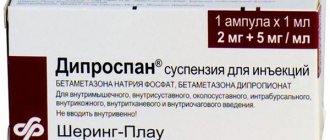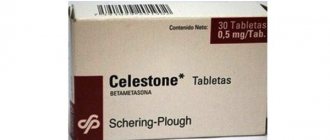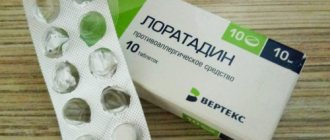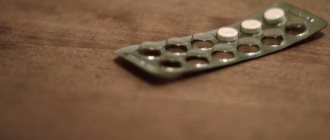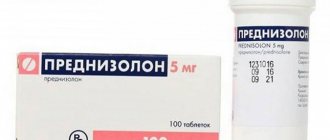pharmachologic effect
Glucocorticosteroid. The active ingredient is betamethasone . The mechanism of action is based on inhibition of the release of interleukins 1 and 2, interferon-gamma from macrophages and lymphocytes. The drug has antiallergic, antishock, anti-inflammatory, immunosuppressive, antitoxic and desensitizing effects. Diprospan does not affect the level of circulating beta-endorphin, but suppresses the release of beta-lipotropin and ACTH from the pituitary gland.
Is Diprospan hormonal or not? The drug is hormonal.
Composition and release forms
Both options are designed to give injections.
The formula of the solution contains betamethasone (betamethasone 1) in the form:
- disodium phosphate (2 milligrams);
- dipropionas (5 milligrams).
The solution is contained in milliliter ampoules, which are packaged in boxes of one or five pieces.
Diprospan, as an injection suspension, includes Betamethasonum (active ingredient) dipropionate in the amount of 6.43 milligrams and sodium phosphate - 2.63 milligrams. These compounds contain the equivalent of 5 and 2 milligrams of the active component, respectively, as well as additional substances:
- liquid for injection;
- chloride, phosphoric acid salt (anhydrous disubstituted), sodium edetate;
- cellulose glycolic acid;
- macrogol 4000;
- benzyl alcohol;
- Tween (or polysorbate) 80 – solvent;
- nipagin (methyl parahydroxybenzoate);
- nipazole (propyl parahydroxybenzoate).
The suspension is supplied in transparent light ampoules or pre-filled syringes with a capacity of 1 ml, placed in cardboard cellular packages of one or five pieces.
Diprospan is not produced as tablets or ointment.
"Diprospan" is produced in transparent glass ampoules. They contain a 1 ml suspension of the drug for injection. Packaging can be of 2 types - 1 or 5 ampoules. The kit also includes disposable syringes with two needles to immediately draw the solution from the ampoule.
Diprospan has a strong anti-inflammatory effect, it quickly relieves pain and has an antihistamine effect. The range of uses of injections is quite wide, but, as a rule, these are diseases of the spine or joints.
The active component of Diprospan is betamethasone. It is contained in the drug in two forms:
- betamethasone disodium phosphate, which ensures rapid achievement of the effect;
- betamethasone dipropionate, which prolongs the therapeutic effect.
The drug exhibits high glucocorticoid and low corticoid activity. The effect of Diprospan in osteochondrosis is due to its influence on various types of metabolism and a pronounced anti-inflammatory effect: its active components suppress the production of substances leading to the development of the inflammatory process. The drug also has an immunosuppressive and antiallergic effect.
Pharmacodynamics and pharmacokinetics
The medication can inhibit the secretion of FSH and TSH. The drug Diprospan stimulates the production of erythropoietins, increases the number of red blood cells, reduces the number of eosinophils and lymphocytes, and increases the excitability of the central nervous system. When the active component interacts with specific cytoplasmic receptors, a complex is formed that is able to penetrate inside the cell, into its nucleus and stimulate the process of mRNA synthesis (it is this that induces the process of formation of lipocortin and other proteins that mediate cellular effects). Lipocortin suppresses the process of release of arachidonic acid , inhibits phospholipase A2, suppresses the process of synthesis of leukotrienes, prostaglandins and endoperoxides, which are actively involved in inflammatory processes and in the formation of an allergic response. Under the influence of Diprospan, the amount of protein in the blood plasma decreases due to globulins, but at the same time the albumin/globulin ratio increases, the production of albumins in the tissues of the kidneys and liver increases, and protein catabolism in muscle tissue increases.
The effect of the drug Diprospan on lipid metabolism: redistribution of fat (fat deposits are localized mainly in the abdomen, face, shoulder girdle), increased synthesis of triglycerides and higher fatty acids, formation of hypercholesterolemia. The effect of the drug on carbohydrate metabolism: activation of phosphoenolpyruvate carboxylase, increased synthesis of aminotransferases (leads to activation of gluconeogenesis), increased absorption of carbohydrates from the digestive tract, increased activity of glucose-6-phosphatase (increases the flow of glucose into the blood from the liver).
The effect of the drug on water-electrolyte metabolism : stimulation of the excretion of potassium ions, retention of water and sodium ions in the body, “washing out” of calcium ions from the skeletal system, decreased absorption of calcium ions from the digestive tract, increased excretion of calcium ions by the renal system. The anti-inflammatory effect is achieved by inhibiting the release of inflammatory mediators by eosinophils; by reducing the number of mast cells (they are the ones who produce hyaluronic acid), inducing the formation of lipocortin, by stabilizing organelle membranes (lysosomal organelles are of particular importance), stabilizing cell membranes, by reducing capillary permeability.
The antiallergic effect is achieved by suppressing the secretion and synthesis of allergic mediators, inhibiting the process of antibody formation, by changing the body's immune response, reducing the sensitivity of effecton cells to allergic mediators, by inhibiting the release of biologically active substances and histamine from mast cells, T-lymphocytes, B -lymphocytes.
For COPD, the drug Diprospan prevents and inhibits the development of swelling of the mucous membranes, slows down the course of inflammatory processes, slows down the deposition of circulating immune complexes in the mucous membranes of the bronchial tree, and reduces the rate of eosinophilic infiltration of the submucosal layer in the epithelia of the bronchial tree. The medication inhibits the process of desquamation and erosion of the mucous membranes. Due to the reduction in production and inhibition of mucus production, its viscosity decreases. Antitoxic and antishock effects are achieved by increasing blood pressure through vasoconstriction, increasing the level of catecholamines circulating in the blood and restoring the sensitivity of adrenergic receptors to them. The effect is achieved through the activation of liver enzymes, which take part in the metabolism of xenobiotics and endobiotics, by reducing the permeability of the vascular walls, as well as due to the membrane protective effect .
The immunosuppressive effect is ensured by a decrease in the rate of release of cytokines (interferon gamma, interleukin-1,2) from macrophages and lymphocytes. The drug suppresses the secretion and synthesis of ACTH, and secondarily inhibits the process of synthesis of endogenous glucocorticosteroids. Under the influence of the medication, the likelihood of scar formation decreases due to inhibition of the speed of connective tissue reactions during inflammation. You can buy Diprospan in the form of suspensions and solution for injection.
Dyshidrotic eczema: 10 photos with descriptions, treatment, causes, symptoms
Any eczema affecting the surface of the skin, manifested by periodic relapses, brings a lot of trouble and is chronic.
Often a person loses the opportunity to work in especially critical moments. The disease is classified into several clinical types, depending on the location of the lesion, the characteristics of its course and the causes of its occurrence.
One of the varieties is dyshidrotic eczema or dyshidrosis.
Persistent relapses manifest themselves in the form of itchy blisters with liquid filling. The main place of occurrence is the arms, or more precisely, the fingers and hands, but sometimes they occur on the feet.
Dyshidrotic eczema in the photo 10 pieces with description
In relation to the overall morbidity, this type was detected in 8% of patients. There is no connection with gender. Both the stronger sex and the weaker half of humanity are sick.
Most often this occurs in the age period of 25–50 years, but it rarely occurs in older or younger people and even in children.
Dermatologists say that those living in cities and metropolitan areas are half as likely to suffer from the disease as those living in villages.
Dyshidrotic eczema. Causes
The main fact of peace is safety for others. After all, dyshidrosis is a non-contagious disease. Despite this, it can cause trouble for the patient for a long time. Sometimes, the phase of acute manifestations does not subside for months. The goal of treatment is based on reducing acute periods and preventing relapses.
Even with the progress of modern medical science, it is difficult to say definitively about the causes of dyshidrotic eczema of the hands . Experts identify factors that largely influence the development and intensity of the disease. People who have the listed points have a greater risk of provocation. The main positions of the leader of the eczema provocateur are awarded:
- Disruption of the metabolic process.
- Immune failure.
- The weakened state of the nervous and endocrine system.
- Digestive problems.
- Past infections.
- Components that cause allergies.
- Strong changes in ambient temperature.
- Genetic factor.
Important! A predisposition to allergies, inherited, is observed in 50% of patients with dyshidrotic eczema. Their parents experienced bronchial asthma, hay fever, and atopic dermatitis.
Violation of sweating on the palms and soles occupy a special place in the etiology. If we talk about children, then some forms of diathesis can be provocateurs. People who work in chemical plants and car repair shops suffer more often. Anyone who frequently comes into contact with harmful substances. Increased risk for cleaners, painters, plasterers, etc.
Find out more
Dyshidrotic eczema on the hands. Photo
Images will help create a complete understanding of the general picture of the disease. Dyshidrotic eczema of the hands, the photo shows in full.
Since all stages can occur at the same time, we also observe initial manifestations in the form of a rash and erosive foci and flaky skin, as well as blisters filled with serous exudate.
The onset of the lesion appears mainly on the fingers.
Dyshidrotic eczema on the fingers, the photo shows a scattering of vesicles that have appeared on the surface. These are characteristic signs by which a dermatologist can diagnose the specified type.
Dyshidrotic eczema. Symptoms
The disease is expressed by clear characteristic symptoms. In this regard, complex diagnostic studies will not be needed. It is enough for the doctor to observe the localization of the rash and the characteristic long-term course. Dyshidrotic eczema on the fingers has distinctive features:
- At the initial stage, redness occurs, and the skin in these places is very itchy.
- The next point is the manifestation of individual elements, vesicles - small bubbles, up to 0.5 cm in diameter. They contain liquid inside, and their shell is dense.
- The initial elements are located quite deep and may not protrude above the skin level. Manifestations often occur in the area of the lateral surface of the fingers. Further, the rashes merge into groups and gradually spread to the arms: palms and hands, and sometimes are noted on the soles of the feet. See how dyshidrotic eczema of the palms looks in the photo.
- Over time, the vesicles burst and form erosions, which are already larger in size and prone to merging. Of course, due to the unbearable itching, a person scratches the sore spots. The bubbles are damaged, but this process will occur without external influence.
- The erosions gradually heal, and the surface of the skin becomes covered with yellow-brown crusts.
- The next stage is complicated by changes in the epidermis. The areas affected by the disease become denser, increased redness and skin pattern, and the formation of cracks are noticed.
- Damaged epidermis opens access to secondary infections. Microorganisms cause inflammation of a purulent nature - pyoderma. Pustules containing pus appear. The patient suddenly becomes worse. Inflammation causes high temperature, swelling and pain occur in the affected areas, and enlarged lymph nodes can be seen that are close to the site of localization.
Dyshidrotic eczema on the fingers is chronic , characterized by alternating states of calm and exacerbation. The painful period often drags on and can last for weeks. It should be noted that the healing of lesions is quite slow. After peeling off the crusts, areas with pigmentation are visible, distinguishing them from healthy skin.
Attention! An irresponsible attitude towards detected symptoms is dangerous. Pathogenic flora, be it fungi or bacteria, can provoke the development of severe complications. The worst-case scenario is infection leading to sepsis.
Although diagnosis is not considered difficult, it is impossible to do without a medical specialist. Several similar painful forms can be confusing, but a dermatologist will successfully differentiate them.
A special type of psoriasis, contact dermatitis and fungal infections are similar. Differences with mycosis are revealed only by examining scrapings in the laboratory.
Moreover, both diagnoses are compatible and are often present simultaneously in one subject.
Dyshidrotic eczema. Treatment
There are various options for defeating dyshidrotic eczema on the hands. But taking control of the situation is difficult. Therefore, the appearance of signs of dyshidrotic eczema on the fingers indicates treatment under the supervision of a competent dermatologist.
Success depends on the individual attitude and action on the main cause causing the painful chain. It is important to start by identifying and eliminating the pathology that provokes relapses.
A mandatory point is to establish healthy functioning of the body:
- Avoid stressful situations.
- Bring metabolic processes back to normal.
- Pay attention to the digestive system.
- Improve your immune system.
- Correct hormonal imbalances, etc.
Eliminate factors that influence negatively. These are detergents, cosmetics and other components that can cause allergic reactions. Limit moments that cause irritation and nervousness.
It is very important to be treated in a complex manner. In conjunction with corrective procedures for the body’s functionality, the doctor prescribes medications, taking into account the presence of inflammatory processes and external rashes.
The use of ointments is designed to improve skin manifestations and restore its integrity. You will see dyshidrotic eczema of the hands and the moments of treatment in the photo.
Prescribed medications of various effects:
- Antihistamines have a sedative effect - aimed at stopping negative reactions.
- Antibiotics are designed to fight bacteria that cause inflammation.
- Products used externally - creams, gels - activate the rapid regeneration of the skin. They have a disinfecting effect. Products containing silver nitrate are good. The body's reactions to irritants are calmed by the use of non-hormonal ointments. If purulent discharge is observed, antiseptics will come to the rescue.
- Hormonal ointments are prescribed for complex cases. Apply for a short time, after the first stages of treatment and calming of acute manifestations. Corticosteroids contained in the composition sometimes provoke an unexpected reaction and aggravate symptoms.
- Vitamins are prescribed to boost immunity, which has a positive effect on the body. Regular multivitamins work well. Additionally, vitamins of group B, as well as A, E, C are prescribed.
- Severe itching and swelling on the extremities is relieved by wrapping with bandages soaked in Burov's liquid. Solutions of amidopyrine or furatsilin help a lot.
All medications are selected very carefully. Treatment is developed individually for each patient. You should not experiment with your own health and take medications on the advice of grandmothers or friends.
Physiotherapy is also widely used in the treatment of dyshidrotic eczema (see photo). Physiotherapeutic measures have a good effect on the body's protective functions. The procedures allow you to minimize the amount of honey. drugs. Good influence:
- Ultrasound, laser and magnetic therapy.
- The use of cold for medicinal purposes is cryotherapy.
- The procedure with pulsed currents is darsonvalization.
- Acupuncture.
- Herbal baths with aroma oils.
- Electrosleep.
- Sanatorium treatment associated with climate change, especially in summer and autumn, has a beneficial effect on recovery.
Traditional medicine recipes recommended for skin diseases have worked well, but do not forget to inform your doctor.
Dyshidrotic eczema. Prevention
The overall health of the body is directly related to the risk of skin diseases. It is possible to keep your body healthy. The main and common option for everyone is to maintain a healthy lifestyle.
After all, critical changes, for example, excess weight, always indicate many deviations in health.
Therefore, regular exercise, fresh air and proper nutrition should be the basis of a person’s life.
People suffering from allergies have a greater risk of suffering from an ailment such as dyshidrotic eczema on the fingers; external manifestations are visible in the photo. The disease brings a lot of trouble. Therefore, it is important to follow a diet.
It is necessary to completely eliminate allergens from your diet.
Wear clothes made from fabrics that do not have synthetic additives. It is difficult to do without household chemicals when taking care of your home, but you can protect yourself by using rubber gloves.
Maintaining good hygiene is important. Choose hypoallergenic soap.
If the disease affects you, pay special attention to nutrition. Try to exclude smoked and fried foods, spicy and sweet foods, as well as allergens. Just limit your salt intake.
Most often, complete recovery does not occur, but it is possible to reduce the frequency of relapses and keep the disease under control. To do this, you will have to strictly follow the specialist’s recommendations, but the efforts will bring good results.
Source: //www.dermatit.net/ekzema/disgidroticheskaya-ekzema-kistej-ruk/
Indications for use of Diprospan
What is Diprospan medicine for?
Indications for the use of Diprospan injections are as follows: the medication is prescribed for shock (toxic, cardiogenic, surgical, burn, traumatic), for anaphylactoid reactions , blood transfusion shock, allergic reactions, anaphylactic shock, status asthmaticus, for severe bronchial asthma, for cerebral edema (after radiation therapy, after surgery), in acute adrenal insufficiency. Also indications for use are: systemic pathology of connective tissue ( rheumatoid arthritis , SLE), poisoning with cauterizing liquids (prevention of the formation of cicatricial narrowings and reducing the severity of inflammation), hepatic coma , acute hepatitis , thyrotoxic crisis . Blockades with Diprospan are often placed.
Is diprospan effective for allergies?
Diprospan is a synthetic glucocorticoid and is used mainly in the treatment of diseases associated with the musculoskeletal system. However, due to its versatile action, the drug is also effective for diseases of the adrenal glands, systemic connective tissue dysfunctions, hematological malignancies, dermatological problems and some other diseases.
In some cases, it is advisable to use diprospan for allergies, but only if treatment with local nonsteroidal or steroidal agents has not produced any results. This is possible if you have the following diseases:
The drug is also indicated in emergency cases, when a person has an acute allergic reaction that requires immediate medical attention. We are talking about acute reactions to drugs, angioedema, generalized urticaria and anaphylactic shock.
Contraindications for Diprospan
Instructions for use of Diprospan do not recommend prescribing the medication intra-articularly for pathological bleeding, for periarticular infections , for septic and infectious lesions of the joint, for severe forms of periarticular osteoporosis, for general infectious diseases, for intra-articular bone fracture, after arthroplasty , for severe bone destruction, for “ dry joint, with osteoarthritis without signs of synovitis, with instability of the joint after arthritis, with aseptic necrosis of the epiphyses of the bones that form the joint.
For fungal, infectious, parasitic and bacterial infections, for herpes zoster, herpes simplex, tuberculosis (latent or active forms), for strongyloidiasis, amebiasis, measles, chicken pox, systemic mycosis Diprospan is used with caution.
In severe infectious diseases, the drug can be prescribed only with simultaneous specific therapy. The drug is not used for diseases of the digestive tract: diverticulitis, peptic ulcer of the digestive system, gastritis, esophagitis , intestinal anastomosis, peptic ulcer, ulcerative colitis . Betamethasone is not prescribed in the post-vaccination period, for lymphadenitis after the BCG . The drug is contraindicated for use in cases of arterial hypertension , diabetes mellitus , hypothyroidism , recent myocardial infarction, decompensated form of CHF, Itsenko-Cushing's disease thyrotoxicosis, nephrourolithiasis , severe pathology of the liver and kidneys, poliomyelitis, obesity, myasthenia gravis , systemic osteoporosis, with hypoalbuminemia, with acute psychosis , glaucoma (closed and open-angle forms), during pregnancy, during breastfeeding.
betamethasone is also a contraindication for Diprospan .
Pregnancy
To date, there is no data on possible risks to the fetus when the mother uses the drug Diprospan, since no studies have been conducted. Taking this into account, such treatment is contraindicated and can be used in exceptional cases when the benefit to the mother outweighs the risk to her unborn child.
If there is a need to use Diprospan injections in nursing mothers, then switching to artificial feeding should be considered, since the penetration of the drug into breast milk and its negative effect on the baby has not been studied.
The use of Diprospan is contraindicated for pregnant women.
During pregnancy, the use of Diprospan for osteochondrosis is not recommended. If the medication is prescribed during lactation, breastfeeding must be stopped. This drug is not used during pregnancy. If it is necessary to take diprospan during lactation, then breastfeeding should be stopped immediately.
During pregnancy, the use of Diprospan for osteochondrosis is not recommended. If the medication is prescribed during lactation, breastfeeding must be stopped.
Due to the lack of controlled studies of the safety of Diprospan during pregnancy, the use of the drug in pregnant women or women of childbearing age requires a preliminary assessment of the expected benefits and potential risks for the mother and fetus.
Newborns whose mothers received therapeutic doses of GCS during pregnancy should be under medical supervision (for early detection of signs of adrenal insufficiency).
We suggest that you familiarize yourself with Isoprinosine 500 instructions for use for children
If it is necessary to prescribe Diprospan during lactation, the issue of stopping breastfeeding should be decided, taking into account the importance of therapy for the mother (due to possible side effects in children).
For children during the period of active growth, glucocorticosteroids are prescribed only for absolute indications. Use should be under close supervision of the attending physician.
This drug is not used during pregnancy. If it is necessary to take diprospan during lactation, then breastfeeding should be stopped immediately.
Side effects of Diprospan
Side effects from the use of the drug Diprospan depend on the ability to comply with the circadian treatment regimen, dosage and duration of use of the medication. Endocrine system: manifestation of latent diabetes mellitus, “steroidal” diabetes mellitus, delayed sexual development in children, Itsenko-Cushing syndrome (myasthenia gravis, amenorrhea, dysmenorrhea , stretch marks, hirsutism , pituitary-type obesity, moon face, increased blood pressure, hirsutism). Digestive tract: loss of appetite, “steroid” ulcer of the gastrointestinal system, pancreatitis, vomiting, nausea, flatulence, hiccups , increased levels of liver enzymes. Cardiovascular system: formation of thrombosis, hypercoagulation , increased severity of CHF, bradycardia, arrhythmia. Nervous system: convulsions, headaches, pseudotumor of the cerebellum, manic-depressive psychosis , euphoria , spatial disorientation , delirium, vertigo, dizziness, insomnia, anxiety , nervousness, increased intracranial pressure, paranoia , depression.
Description of the side effects of Diprospan on the sensory organs: posterior subcapsular cataract, sudden loss of vision, exophthalmos , trophic changes in the cornea, increased intraocular pressure. Metabolism: increased sweating, increased protein breakdown, negative nitrogen balance, increased body weight, hypocalcemia, increased excretion of calcium ions from the body. Musculoskeletal system: osteoporosis, atrophy and decrease in muscle mass, “steroid” myopathy , rupture of muscle tendons, slowing down the processes of ossification and growth of the skeletal system in children as a result of premature closure of the epiphyseal growth zones. Skin: tendency to develop candidiasis and pyoderma, steroid acne, pigmentation disorders, thinning of the skin, formation of ecchymoses and petechiae, slow wound healing. It is possible to form an allergic response, leukocyturia . With intravenous administration, convulsions, “flushes” of blood flow to the face, and arrhythmias are possible.
Contraindications and application features
This product has many contraindications and application features. If you have any doubts about treatment with Diprospan, you should consult your doctor for advice and clarification. In this case, be sure to report all diseases and reactions to medications.
Contraindications
Conditions that prohibit treatment with the drug:
- increased individual sensitivity to the drug;
- breast-feeding;
- subcutaneous or intravenous administration of the solution;
- pregnancy;
- children's age (up to 3 years);
- presence of infection.
The presence of certain diseases may be considered relative contraindications. If they exist, the reasonable risk and expected therapeutic effect from the administration must be taken into account:
- diabetes;
- stomach ulcer;
- purulent foci in the body;
- viral infections;
- severe hypertension;
- glaucoma;
- tuberculosis;
- thromboembolic syndrome;
- mental illness.
Overdose
It is recommended to use the drug strictly according to the instructions. If the dosage is exceeded, the following effects are possible:
- depression;
- excitation;
- nausea;
- sleep problems;
- vomit.
In case of overdose, it is necessary to urgently seek medical help and give the patient more fluids.
Side effects
Harmful effects of the drug and significant side effects can occur with incorrect dosage and long-term treatment. With a short therapeutic course, adverse reactions and complications practically do not occur.
Possible side effects:
- allergic manifestations;
- cataract;
- glaucoma;
- disturbances in the functioning of the heart;
- mental disorder;
- erosions and ulcers in the gastrointestinal tract;
- decline in immunity;
- problems with bones, cartilage and other types of tissue;
- growth retardation;
- Cushing's syndrome.
Diprospan injections, instructions for use
betamethasone dosage regimen and route of administration are selected depending on the nature and severity of the underlying disease.
According to the instructions for use of Diprospan, the infusion solution is diluted in a 0.9% sodium chloride solution or in a dextrose solution before administration. Only freshly prepared solution can be administered. Diprospan injections are given deep intramuscularly at a dose of 4-8 mg for severe pathology.
Periarticular and intraarticular injections of the drug are carried out into very large joints at a dose of 4-8 mg. An injection into the joint directly allows for a more effective effect on the inflammatory process in it. Injections are also given into the knee, but it is better to entrust such injections to doctors, as this is a complex process.
For skin diseases, the drug is administered inside the wound or intradermally at a dose of 0.2 ml/square centimeter.
For bursitis, local infiltration is carried out: 1-2 mg. If necessary, the drug can be administered subconjunctivally at a dose of 2 mg.
When using the medication, it is very important to consider contraindications.
The product is not available in the form of ointments or tablets.
How many times can you inject and how often?
It is better to consult your doctor about this, who will select the dose necessary for you. Uncontrolled use of the drug negatively affects the condition of the body.
Advantages of diprospan over other injectable steroids
Diprospan solution consists of two fractions: water-soluble (betamethasone sodium phosphate) and microcrystalline (betamethasone dipropionate). The first ensures the speed of action of the drug: betamethasone sodium phosphate easily enters the blood and spreads throughout the body within a few minutes. The second fraction forms a kind of “depot” at the injection site, from which betamethasone seeps into the vessels literally “drop by drop,” maintaining a constant concentration of the drug in the blood for 20-25 days. As a result, when taking the drug, the acute inflammatory process is initially quickly relieved, and then a long-term - 3-4 week - remission occurs.
The dual mechanism of action allows you to achieve maximum effect when using minimal doses of the hormonal drug, which is especially important in acute conditions in allergy sufferers (for example, anaphylactic shock or generalized urticaria). One injection of Diprospan for allergies can replace a multi-day injection course of low-active steroids.
Interaction
Diprospan reduces the effectiveness of anticoagulants , insulin, antihypertensive drugs, and oral hypoglycemic medications. The drug weakens the activity of vaccines and the effect of diuretics . The use of barbiturates, phenytoin, and rifampicin weakens the effect of the drug. The risk of side effects increases when treated with antipsychotics, estrogens, androgens, NSAIDs, immunosuppressants , ritodrine, digitalis glycosides, nitrates, tricyclic antidepressants . Diprospan increases the severity of the hepatotoxic effects of paracetamol. Carbonic anhydrase inhibitors and amphotericin B increase the risk of osteoporosis. The drug slows down the metabolism of cyclosporine and increases its toxicity, enhances the metabolism of mexiletine, isoniazid, and increases the concentration of folic acid. The medication reduces the effectiveness of somatotropin .
Diprospan for eczema
The drug belongs to the group of glucocorticosteroids. The main effect of Diprospan is associated with pronounced glucocorticoid activity; the mineralocorticoid effect is practically not expressed. The action of Diprospan is aimed at suppressing inflammation, allergic reactions, and immunosuppression. Inhibits the function of the pituitary gland.
Diprospan is a medicine that consists of two active components with different rates of action.
One of them, betamethasone sodium phosphate, easily dissolves, hydrolyzes and is absorbed after administration, providing a rapid therapeutic effect. Discharged within 24 hours.
The other, betamethasone dipropionate, creates a depot after administration, from which it is released gradually. As a result, a long-lasting effect of the drug is ensured. The time for complete elimination is 10 days or more.
Diprospan crystals are very small, which allows it to be inserted into small joints through a very thin needle.
Azathioprine, when used for a long time together with Diprospan, can contribute to the appearance of cataracts and myopathy.
Anabolic steroids, delagil, ibuprofen - increase the side effects of the drug. Diprospan reduces the incidence of allergic reactions from antibiotics when used simultaneously.
For glaucoma, it is not recommended to use Diprospan together with antidepressants due to the high likelihood of increasing intraocular pressure.
When isoniazid is used together with Diprospan, a decrease in concentration is observed. Mental disorders may occur.
Antiepileptic drugs reduce the concentration of Diprospan - therefore, its therapeutic effect decreases, which requires an increase in the dose of the drug.
The likelihood of ulcers in the digestive tract increases when Diprospan is used simultaneously with ibuprofen, aspirin, indomethacin, butadione.
Estrogen preparations (including contraceptives) increase the therapeutic effect of Diprospan. Side effects may also increase.
Release form and composition
Available in the form of solution and suspension for injection. The solution is packaged in ampoules of 1 ml, 1 and 5 ampoules per box. The suspension is packaged in ampoules or syringes of 1 ml. In plastic cellular packaging - 1 or 5 ampoules, packed in a cardboard box.
1 ml of suspension contains 6.43 mg of betamethasone dipropionate (equivalent to 5 mg of betamethasone) and 2.63 mg of betamethasone sodium phosphate (2 mg of betamethasone equivalent). Excipients:
- water for injections;
- anhydrous disodium phosphate;
- trilon B;
- sodium chloride;
- benzyl alcohol;
- polysorbate 80;
- polyethylene glycol 4000;
- nipazole;
- carboxymethylcellulose sodium salt;
- nipagin.
The solution for injection contains betamethasone: in the form of disodium phosphate - 2 mg, in the form of dipropionate - 5 mg.
Diprospan: contraindications
- Rheumatic diseases: rheumatoid arthritis, bursitis, eosinophilic fasciitis, ankylosing spondylitis, osteoarthritis, epicondylitis, lumbago, exostosis, tendinitis, bursitis against the background of hard callus, stiffness of the big toe, torticollis, heel spur.
- Allergic diseases: bronchial asthma and status asthmaticus, allergic rhinitis, serum sickness, atopic dermatitis, drug allergies, urticaria, allergic reactions to insect and snake bites.
- Systemic diseases: scleroderma, periarteritis nodosa, systemic lupus erythematosus, dermatomyositis.
- Skin diseases: contact dermatitis, insulin lipodystrophy, arthropathic psoriasis, lichen planus, keloid scars, alopecia areata, common pemphigus, diffuse forms of neurodermatitis and eczema.
- Blood diseases: leukemia and lymphoma, transfusion reactions.
- Diseases of the adrenal glands: primary and secondary adrenal insufficiency and adrenogenital syndrome.
- Diseases of the digestive tract: ulcerative colitis, celiac enteropathy, Crohn's disease.
- Kidney diseases: glomerulonephritis, nephrotic syndrome.
If long-term treatment is necessary, it is necessary to take into account the presence of concomitant diseases in which it is better to refrain from using Diprospan (relative contraindications):
- severe arterial hypertension;
- diabetes;
- viral and purulent infections;
- osteoporosis;
- vaccination period;
- systemic fungal infection of the skin and mucous membranes;
- stomach ulcer;
- Cushing's syndrome;
- tuberculosis;
- mental illness;
- glaucoma;
- thromboembolic syndrome;
- intramuscular injection for thrombocytopenic purpura.
There are also certain contraindications for administering Diprospan into a joint or periarticularly:
- infectious arthritis;
- periarticular cellulitis with ulcerations;
- infective endocarditis;
- aseptic necrosis in the adjacent epiphyses;
- osteomyelitis;
- treatment with anticoagulants;
- foci of psoriasis at the injection site;
- joint instability;
- diabetes;
- hemarthrosis.
Diprospan: instructions for use
For systemic use, it is administered intramuscularly. For arthritis, the best effect is achieved when Diprospan is administered into the joint or periarticularly. For eye diseases, the drug can be administered through the skin in the lower eyelid area. Administration of Diprospan intravenously and subcutaneously is contraindicated!
The dose of the drug in each individual case is selected individually and depends on the disease and its severity. Diprospan is administered to create a drug depot in the body against the background of hormonal therapy with short-acting drugs.
How is Diprospan harmful, and what side effects are observed when using it?
When Diprospan is administered, consequences in the form of adverse reactions occur extremely rarely, more often after long-term use. They are mainly associated with inhibition of the pituitary gland.
//www..com/watch?v=o4mps4NP36Q
But there is still a small likelihood of developing side effects that occur with the use of many glucocorticoid hormonal drugs:
- Cushing's syndrome: weight gain, the appearance of stretch marks and areas of atrophy on the skin, acne, osteoporosis, diabetes mellitus, decreased libido and menstrual irregularities, myopathy.
- Growth retardation due to inhibition of pituitary gland function, and disruption of the formation and growth of cartilage, bone tissue and muscles.
- Increases the body's susceptibility to bacterial, fungal and viral infections.
- Ulcerogenic effect. Under the influence of glucocorticoids, the risk of developing ulcers in the stomach and duodenum increases.
- Disorders of the nervous system and psyche. There may be sleep disorder, irritability, euphoria, anxiety, depression with suicide attempts, convulsive seizures.
- Under the influence of glucocorticoid hormones, it is possible to increase blood pressure and develop myocardial dystrophy.
- Ophthalmological diseases can develop cataracts, glaucoma, and corneal perforation due to herpetic lesions of the eye.
- Allergic reactions and anaphylactic shock.
- At the site of drug administration, lesions with disturbed pigmentation, aseptic abscesses, atrophy of the skin and subcutaneous fat may occur.
Source: //psoriazs.ru/blog/diprospan-pri-ekzeme/
special instructions
Diprospan can be mixed with solutions of local anesthetics in equal volumes. It is unacceptable to use the medication in the treatment of hyaline membrane disease in newborns. The drug should not be injected into the intervertebral spaces, into infected areas and unstable joints. Before starting treatment, it is necessary to conduct an examination: a general blood test, blood glucose levels, electrolytes. For concomitant tuberculosis, sepsis, and intercurrent infections, antibiotics are administered simultaneously. Reviews of the drug indicate the high effectiveness of the drug if all recommendations are followed. It is important to consider that in patients with hypothyroidism, the clearance of glucocorticosteroids is reduced; in thyrotoxicosis, the opposite effect is recorded.
There is no Wikipedia article about the medicine.
Doses, course of treatment
It is important to remember that the dosage and duration of use of the drug is selected by the doctor individually for each patient. It all depends on the complexity and type of disease. If Diprospan is prescribed for emergency purposes, the usual dosage for a single administration is from 0.5 to 2 ml. The medicine is administered intramuscularly into the patient's buttock. If the doctor sees a need, he may prescribe repeated injections against allergies. When the treatment was not so effective and did not bring the expected positive effect, the specialist advises the patient to undergo infusion therapy with other systemic corticosteroids. To cure the chronic form of the disease, a single application or a course lasting up to several weeks may be necessary. Everything is individual, you must always remember this. Allergic bronchitis, hay fever, urticaria, bronchial asthma can be cured with one or more injections of Diprospan.
The specific number of injections is determined by the doctor. With regards to rhinitis of an allergic nature, it is possible to prescribe one injection. It is performed in the fold of the skin of the vestibule of the nose. The medicine is administered into each nostril 0.5 ml. If a patient is diagnosed with psoriasis with a parallel course of psoriatic arthritis, Diprospan can be prescribed for long-term treatment. In this case, the drug is injected every one to two days into the gluteal muscle, 2 ml. After achieving a clinical effect (this usually occurs after 20-30 days), the dosage of the drug begins to be reduced to the minimum. When the drug is completely discontinued, the patient should be under the supervision of a doctor for another year. Sometimes it takes more time.
Reviews about Diprospan
Good reviews about Diprospan injections are very common. The drug is mentioned as a powerful anti-inflammatory and antiallergic agent that quickly relieves all unpleasant symptoms.
The medicine Diprospan copes with psoriasis quickly and efficiently, everyone has a generally good opinion about it. The medication also helps with eczema, the use of the drug has positive reviews for arthrosis. However, although the medicine is quite effective, it sometimes has side effects, such as weight gain and shortness of breath.
Diprospan for allergies, reviews from doctors
This remedy should be used only as prescribed by a doctor, and should not be abused under any circumstances. The medication stops an allergic attack, however, the use of the drug also has a poisonous effect on the body.
Diprospan price, where to buy
The price of 1 ampoule of Diprospan is about 220 rubles. You can buy the drug in Moscow for about 230 rubles.
The price of Diprospan injections in Ukraine is 1100-1600 UAH for 5 ampoules of 1 ml.
How much does an allergy shot cost, for example, in Kharkov? Approximately 250 UAH. In Odessa - 290 UAH.
Tablets of this drug are not sold.
- Online pharmacies in RussiaRussia
- Online pharmacies in UkraineUkraine
- Online pharmacies in KazakhstanKazakhstan
LuxPharma* special offer
- Diprospan amp. No. 1
Pharmacy Dialogue
- Diprospan ampoules 2mg+5mg/ml 1ml No. 1Shering-Plough
Europharm* 4% discount using promo code medside11
- Diprospan injection suspension 1 ml 1 amp without packaging
show more
Pharmacy24
- Diprospan 1 ml No. 5 solution Schering-Plough Labo N.V./Schering-Plough, Belgium/France
- Diprospan 1 ml No. 1 powder SENEXI HSC-EROUVILLE SAINT-CLAIR, France
PaniPharmacy
- Diprospan ampoule Diprospan injection suspension ampoules 1 ml No. 5 Belgium, Schering-Plough Labo
- Diprospan syringe Diprospan injection suspension syringe 1 ml with 2 needles No. 1 Belgium, Schering-Plough Labo
show more
Description of the drug Diprospan
The owner of the registration certificate, which controls the quality of Diprospan, is the pharmaceutical corporation Schering-Plough, France. The instructions for the drug were officially approved in 2011, the price is set by pharmacy chains. Suspension for injection produced in Belgium can be purchased for 206 rubles. – 1 ampoule (1ml). Prescription drug. Valid for 18 months. Store Diprospan at room temperature, in a dark place, out of reach of children.
Patients often have questions: Dexamethasone or Diprospan, Flosteron or Diprospan - which is better? Flosterone is a complete analogue of Diprospan, both in terms of the active substance and the amount of Betamethasone, is available in the same dosage form, and has the same spectrum of action. But recently, Flosteron is rarely found in pharmacies.
Betaspan Depot is also a complete analogue of Diprospan, its price is 523 rubles. for 7 ampoules. Dexamethasone is a fluorinated derivative of Prednisolone. It exhibits similar pharmacological properties, but as studies show, the amount of side effects of Dexamethasone is much greater, and the duration of action is shorter.
Diprospan relieves the symptoms of the disease, but does not cure it. Irrational prescription and abuse of Diprospan is fraught with a large number of side effects that can worsen the patient’s quality of life.
